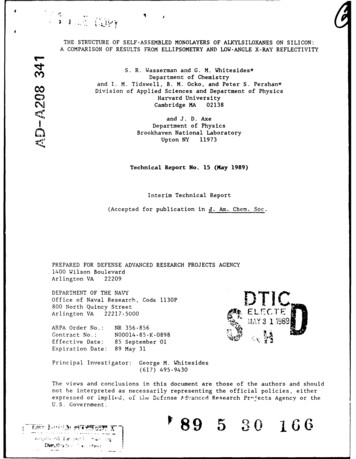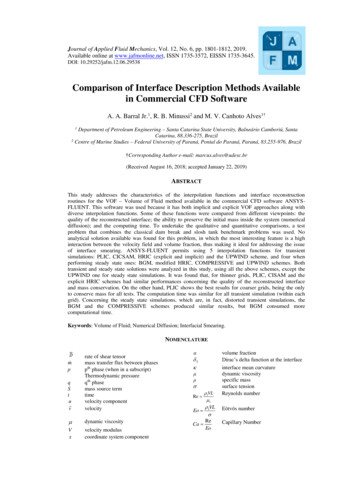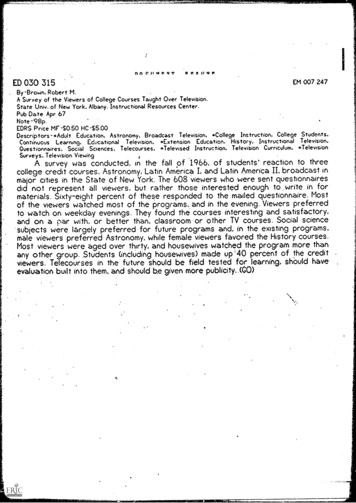
Transcription
VVTHE STRUCTURE OF SELF-ASSEMBLED MONOLAYERS OF ALKYLSILOXANES ON SILICON:A COMPARISON OF RESULTS FROM ELLIPSOMETRY AND LOW-ANGLE X-RAY REFLECTIVITY4S.R. Wasserman and G. M. Whitesides*of Chemistry(Departmentand I. M. Tidswell, B. M. Ocko, and Peter S. Pershan*Division of Applied Sciences and Department of PhysicsHarvard UniversityCambridge MA02138000and J. D. AxeDepartment of PhysicsBrookhaven National Laboratory11973Upton NYTechnical Report No. 15 (May 1989)Interim Technical Report(Accepted for publication in J. Am. Chem. Soc.PREPARED FOR DEFENSE ADVANCED RESEARCH PROJECTS AGENCY1400 Wilson BoulevardArlington VA22209DEPARTMENT OF THE NAVYTIOffice of Naval Research, Code 1130P800 North Quincy StreetArlington VA422217-5000ARPA Order No.:Contract No.:Effective Date:Expiration Date:.TELFCT EhWS4Y1 989DNR 356-856N00014-85-K-089885 September 0189 May 31Principal Investigator:George M. Whitesides(617) 495-9430The views and conclusions in this document are those of the authors and shouldnot be interpreted as necessarily representing the official policies, eitherexpressed or implied, of Lhe Defense Ad,:anced Research Pr-jects Agency or theU.S. Government.89 5 3 01661 6
REPRODUCEDAT GOVERNMENTEXPENSESC.jRITy CLASSIFiCATION OF 7i.iS PAGEREPORT DOCUMENTATION PAGE!REPORT SECURITY CLASSIFICATION1b. RESTRICTIVEMARKINGSUnclassified.a SECURITY CLASSIFICATION AUTHORITY3. DISTRIBUTION tAVAILABILITY OF REPORTApproved for public release; distribution20. DECLASSIFICATION IDOWNGRADING SCHEDULEunlimited4 PERFORMING ORGANIZATION REPORT NUMBER(S)S. MONITORING ORGANIZATION REPORT NUMBER(S)Technical Report # 156a6o.OFFICE SYMBOLNAME OF PERFORMING ORGANIZATIONHarvard University(if applicable)6C. ADDRESS (Cty,Stare. and ZIP Code):7a. NAME OF MONITORING ORGANIZATIONOffice of Naval Research7b. ADDRESS (Ciry, State. and ZIP Code)Otfice of Sponsored ResearchHolyoke Center, Fourth FloorCambridge MA02138-4993Sa. NAME OF FUNDING/SPONSORINGORGANIZATIONCode 1130P800 North Quincy StreetArlington VA22217-50008b. OFFICE SYMBOL(If applicable)9. PROCUREMENT INSTRUMENT IDENTIFICATIONNUMBERONR/DARPA8c. ADDRESS (City, State, and ZIP Code)10 SOURCE OF FUNDING NUMBERS800 North Quincy StreetArlington VA22217-5000TITLE (IncluDe Security Claz,,cat oniSilicon:.2PROGRAMELEMENT NO.85-K-0398WORK UNITACCESSION NOTASKNO.NR 356-856I"The Structure of Self-Assembled Monolayers of Alkylsiloxanes onA Comparison of Results from Ellipsometry and Low-Angle X-Ray Reflectivity"aDERSONAL AUTHOR(S)Wasserman, S. R.: Whitesides'3aPROJECTNO.TYPE OF REPORT13b TIME COVEREDinterimIISet al. PAGE COTN.May 1989NOTATION/COSATI CODESFIELD14. DATE OF REPORT (Year, Month, Day)F.TO 6.SUjPPLEMVENTARY'7M.; Tidswell, I. M.; Ocko, B.18 SLISUB-GROUPGROUfTjERMS (Continue on reverse if necessary and identify by block number)self, assembly, monolayer, alkylsiloxane, ellipsometry,Xf-ray reflectivity,9 ABSTRACT .(Continue othickness) rOk'Ajcot-, f",,o[7, gl'ov, Krjeverse if necessary and identify by block number)The thicknesses of alkylsiloxane monolayers on siliconisilicon dioxide substrates have been measured usinge'lipsometry and low angle X ray reflection.measured by the two methods differ by 2.2Thicknesses(rlms)for alkylchains of 10 - 18 carbon atoms and have a maximum differenceof 4.2 eu DISTRIBUTION/AVAILABIL'YM UNCLASSIFIEDIUNLIMITEDEllipsometry systematically yields a largerOF ABSTfCT[ SAME AS RPT,a NAME OF RESPONSIBLE INDIVIDUALDr. Joanne MillikenDO FORM 1473, 84 MAR21. ABSTRACT SECURITY CLASSIFICATIONCD DTIC USERS22b. TELEPMONE (Include Are& Code)83 APR ea:tln may be usea unti exnaustea.A,:o:e, ea,*,ons are oosoeteSECI22c OFFICE SYMBOLR1rV CLASSFICATONJ OF THIS PAGE
19.QABSTRACT (Cont'd)thickness.This discrepancy may result from differencesbetween the two techniques in their sensitivity to thestructure of the interface between silicon dioxide and thealkylsiloxane monolayer.The X-ray reflectivity measurementsprovide e-itence that these organic monolayers do not buildup as island structures and demonstrate that the approximatearea projected by each alkyl group in the plane of themonolayer is0,,#1'. ) Preliminary studies indicate thatthe use of this technique to follow changes in the structureof a monolayer as a result of transformations in itsconstitution are complicated by damage (often oxidation) to/the monolayer that is induced by X-ray radiation.Accesslon For S--GA&I--ASPI11itv Codes--e.nd/orc allIji )
onSilicon:fromEllipsometryandAI ayofofResultsReflectivityStephen R. Wasserman and George M. Whitesides*Department of Chemistry, Harvard University, Cambridge, MA02138Ian M. Tidswell, Ben M. Ocko, and Peter S. Pershan*Division of Applied Sciences and Department of Physics,Harvard University, Cambridge, MA 02138John D. AxeDepartment of Physics, Brookhaven National Laboratory, Upton,NY 11973AbstractThe thicknesses of C10-C18 alkylsiloxane monolayers onsilicon-silicon dioxide substrates have been measured usingellipsometry and low angle X-ray reflection.Although, forany given sample, thicknesses measured by the two methodsagree tc within experimental error, ellipsometricmeasurements are systematically larger by approximately 2 A.This difference may result from variations in the sensitivityof the two techniques to the structure of the interfacebetween silicon dioxide and the alkylsiloxane monolayer.TheX-ray reflectivity measurements provide evidence that these-1-
-2organic monolayers do not build up as island structures anddemonstrate that the approximate area projected by each alkylgroup in the plane of the monolayer is-21 3 A 2 .Preliminary studies indicate that this technique can be usedto follow the changes in the structure of a monolayer whichresult from chemical transformations.The influence ofdamage that is induced by X-ray radiation on thesemeasurements is discussed.
-3IntroductionThis paper describes the use of ellipsometry andlow-angle X-ray reflectivity to characterize monolayersprepared by reaction of alkyltrichlorosilanes with thesurface silanol groups of silicon bearing a hydrated nativeoxide.Our primary objective was to compare estimates of thethicknesses of these films obtained using these twotechniques.Ellipsometry has been employed extensively forthe measurement of the thicknesses of thin organic films.1- 5X-ray reflectivity is just beginning to be used for thispurpose. 6 - 1 1Agreement between ellipsometry and X-rayreflectivity would help to validate both techniques.Asecondary objective was to examine the structural order ofthese self-assembled alkylsiloxane monolayers.As part ofthis work we have attempted to generate monolayers that havea variation in electron density along the normal to thesubstrate surface.The intensity of the X-rays reflectedfrom such samples is sensitive to this type of change inelectron density. 6'12The determination of the electrondistribution in films ostensibly having variations inelectron density along the z-axis would provide one directmeasure of order in these systems.Previous studies have attempted to verify the accuracyof ellipsometry in determining the thicknesses of organicmonolayers.For Langmuir-Blodgett monolayers estimates ofthickness by ellipsometry, isotopic labelling, 1 3 , 1 4 andsurface pressures 1 5 are in agreement.These experiments
-4depended, however, on comparisons of complete and partialmonolayers and demonstrated only that the thickness of amonolayer as measured by ellipsometry correlates with thenumber of molecules per unit area in that monolayer and theirlength.We have reached a similar conclusion whencorrelating the ellipsometric thicknesses of monolayersprepared from a homologous series of alkyltrichlorosilaneswith the relative intensities of carbon and silicon observedin X-ray photoelectron spectroscopy (XPS).16This conclusionhas also been reached in related experiments that utilizedmonolayers of alkyl thiols adsorbed on gold films. 1 7Against the background of these earlier studies, we hadtwo reasons to conduct a comparison of results fromellipsometry and X-ray reflection.First, these previousstudies did not directly measure the thickness of themonolayers.Second, they examined Langmuir-Blodgett, ratherthan self-assembled, monolayers.The self-assembled monolayers used in this work wereprepared by placing a silicon-silicon dioxide(Si/Si02)substrate in a solution containing an alkyltrichlorosilane(RSiCl3) .18The Si-Cl bonds react with silanol groups 1 9 andadsorbed water 2 0 present on the surface of the silicondioxide, and form a network of Si-O-Si bonds of undefinedstructure. 2 1The resulting monolayers are bound covalentlyto the substrate and are stable.X-ray photoelectronspectroscopy (XPS) reveals that no chlorine remains inthem. 1 6The density of surface silanol groups on the native
-5oxide is only-1 per 20 A 2 .2 2 , 2 3This density isapproximately equal to the surface density of R groups withinthe monolayer (see below).The remaining Si-Cl bonds of theRSiCI3 groups apparently react with water 2 4 and form -Si-OSi- and/or -Si-OH moieties.Ellipsometry and low-angle X-ray reflection are bothoptical techniques based on the reflection of light frominterfaces.Although these two techniques are describedusing the same theoretical treatment -- Fresnel's equationsfor the reflection of light 2 5 -- they measure differentproperties of the light reflected from an interface.Inaddition, the wavelengths of the light used here inellipsometry (l 6328 A) and X-ray reflection (X 1.5 - 1.7The two techniquesA) differed by more than a factor of 103are also sensitive to different facets of interfacialstructure.ResultsPreparationof Monolayers.Wepreparedalkylsiloxane monolayers on silicon-silicon dioxide (Si/SiO2 )substrates by reaction with alkyltrichlorosilanes using16 18 2 6techniques similar to those described previously. , ,Because the measurement of X-ray reflection requires large,flat samples, the silicon substrates for these studies weresignificantly larger(0.125 in.)(2.5 x 7.5 cm) and, in general, thickerthan those used previously. 2 7however, prepared on thin(0.015 in.)Some samples were,substrates. 2 8We
-6examined monolayers prepared from saturated alkyltrichlorosilanes(Cl3Si(CH2)nCH3, n 9,11,14,15,17),decenyltrichlorosilanefluorinated silaneEllipsometry.from 16-hepta-(HTS, C13Si(CH2)15CH CH2),and from a(Cl3Si(CH2)2(CF2)7CF3 ).The theory of ellipsometry has beendiscussed in detail by others. 129Here we summarize certainimportant details and assumptions of the method.Ellipsometry analyzes the reflection of ellipticallypolarized light from an interface separating two media withdifferent indices of refraction.This elliptically polarizedlight can be represented as the sum of two components, one inthe plane of incidence of the light (p polarization),other perpendicular to this plane(s polarization).theUponreflection the amplitude and phase of each of thesecomponents is altered, resulting in a change in the overallpolarization and amplitude of the light wave.These changesin amplitude and phase are represented by the Fresnelreflection coefficients for the p and s polarizations, rp andrs .p.Ellipsometry measures the ratio of these coefficients,The standard relationships between p and the measuredanalyzer(A) and polarizer(P) angles are summarized inequations 1-3.1,29p-o - tan 41 exprsy AA (iA)(1)(2)2P n/2(3)
-7The angle 4 represents the ratio of the changes in amplitudefor the s and p polarizations of light upon reflection froman interface.The angle A is the difference in the phaseshifts that are experienced by each polarization uponreflection.In order to use ellipsometry to determine the thicknessof a monolayer supported on a substrate, one must comparedata obtained from the monolayer-substrate system with thosefrom the uncoated substrate. 3 0This comparison isstraightforward, but differences between the substrate incoated and uncoated form may skew the ellipsometric results.Clean silicon-silicon dioxide has a high surface free energyand, therefore, a high affinity for both water and organiccontaminants.Organic monolayers terminating in methyl andvinyl groups have low interfacial free energies and resistcontamination. 3 1If contamination of the bare Si/SiO2substrate were significant, we would expect that thethicknesses of the monolayer, as measured by ellipsometrywould be too small.We have found that the thicknesses ofthese a-alkylsiloxane monolayers correspond very closely tothose which we expect for a trans-extended chain orientedperpendicular to the surface: 1 6 that is, to the largestplausible thickness.A trans-extended chain is in agreementwith infrared measurements of chain geometry. 3 2We conclude,based on these two lines of evidence, that contamination doesnot appear to affect the ellipsometric results in thesesystems. 33
-8The conventional intezpretation of the ellipsometricdata is based on a model consisting of parallel interfacesseparating air, the alkylsiloxane monolayer, and thesubstrate (Figure 1).The effectively infinitely thicksubstrate has a refractive index n2, the monolayer has auniform refractive index nl, and the ambient atmosphere hasrefractive index n o(which is assumed to be 1).Since thesilicon substrates have a native surface oxide layer. 3 4 ,3 5 athree-layer model might, in principle, provide a moreaccurate representation of the structure of the monolayer.In practice we have used a two-layer model and have measureda single effective refractive index for the substrate thatcombines contributions from the bulk silicon and the surfaceoxide. 3 6Although we assume that the two interfaces,monolayer-substrate and air-monolayer, are perfectly smoo.h,theoretical and experimental studies suggest that, forellipsometry, roughness has little effect on the measured9thickness of the monolayer. 3 7 - 3Ellipsometry can, in principle, determine both thethickness and the refractive index cf a monolayer.very thinFor the( 50 A) films examined here, it is not, however,possible to determine both of these quantitiessimu'taneously. 4 0We must, therefore, assume a value tor oneof them before calculating the other.We have chosen tomodel the monolayer as a transparent medium with a refractiveindex of 1.45;41 other investigators have used a refractiveindex of 1.50 for organic monolayers. 5Our value is
-9-Figure1. Two-layer model used for ellipsometry.Thesilicon substrate has refractive index n2, themonolayer has refractive index ni, and the ambientair has refractive index no.The interfacesbetween each layer are assumed to be perfectlysharp.For the alkylsiloxane monolayers onsilicon n 2 is3.8, ni is-assumed to be 1. 40 and 02 1.45, and n o isThe incident angle of the laserlight, 00, is 70 .01-The angles of refraction,150, are given by Sneli's law(nlsinol n2sinO2).
-10-NCCc.
-I1-approximately that of pure liquid and crystalline paraffins(1.42-1.44)42 but is lower than that of high densitypolyethylenes (1.49-1.55). 4 3While our choice of refractiveindex is somewhat arbitrary, the X-ray reflectivitymeasurements(see below) suggest that the electron density in4 4-47these monolayers is similar to that of bulk paraffins.For the monolayers examined here, an increase of 0.05 in theassumed value of the index of refraction of the monolayer48would decrease its calculated thickness by - 0.8 - 1.3 A.For ellipsometry we used a helium-neon laser (X 6328A) as the light source.Other wavelengths within the visibleregion would provide similar results. 5The method has anaccuracy on the order of 2 A.Low-AngleX-RayReflectivity.Thereflection ofX-rays from surfaces 6 has been used to characterize thestructural properties of several systems, includingliquids 4 9 - 5 1 and liquid crystals. 5 2 - 5 4We and others havealready described the theory of this technique 5 5 and its usefor the characterization of the structure of monolayersprepared from alkyltrichlorosilanes. 8 , 2 7We will onlysummarize certain features of the method.Low-angle X-ray reflectivity measures the intensity, R,of X-rays that are reflected from a surface as a function ofthe angle,e, betweenthe incoming X-ray beam and the sample.In general the variation of this intensity with 0 is given byFresnel's laws.The intensity also varies as a result of thechange in the difference in phase between X-rays reflected
-12 -from the air-monolayer and monolayer-substrate interfaces.Ris related to dPel/dz , 5 6 the average derivative of theelectron density along the normal (z) axis of the substrate,by equation 4.Here hqz(eq 5) is the change in momentumCORJI pRF dpel/dz exp(iqzz) dz1 2(4)-00qz 4-1 sinO(5)experienced by the X-ray photons during the reflectionprocess, 5 7 while p,, is the electron density of the bulksubstrate.RF is the Fresnel reflectivity, the intensity ofX-rays reflected from a bare substrate whose boundary with avacuum is sharp and perfectly smooth.If the refractiveindex of the substrate is known, the form of RF is determinedsolely by the Fresnel reflection coefficients.This index ofrefraction is calculated from the critical angle, Oc, fortotal reflection of the X-rays. 5 5The refractive index inthe X-ray region is a linear function of the electrondensity, Pel. 5 8The change in electron density dPel/dz istherefore a direct measure of dn/dz.Equation 4 describes the pattern of interference thatresults from the reflection of X-rays from an arbitraryelectron distribution, Pel(Z).In the case of two sharpinterfaces separated by some distance, eq 4 reduces to thefamiliar interference condition for reflection from parallel
-surfaces. 5 9 , 6 013 -Since the measured interference patterndepends on the actual distance separating the two interfacesin our monolayer system, this method, unlike ellipsometry,directly measures the thickness of the monolayer.Our experiments utilized two monochromatized sources ofX-rays: a rotating anode (XSynchrotron Light Source1.54 A) and the National(NSLS, X 1.71 A).We present thedata obtained from these two sources as a function of qzbecause the interference pattern is invariant in qz,regardless of the wavelength of radiation used.usually present our data in the form R/RF.We will alsoSince for asingle sharp interface R RF, 5 9 R/RF 1 for all qz.Anydivergence of Pel from that characterizing a single idealinterface is, therefore, readily apparent as deviations inR/RF from a horizontal line.The interpretation of the observed interference pattern(Figure 2 shows typical data) requires fitting it to astructural model of the monolayer that incorporates changesin the electron density along the surface normal (dPel/dz).We have analyzed our data using a treatment described indetail elsewhere 61 and summarized graphically in Figure 3.This two-layer model is the simplest plausible model for thedescription of the alkylsiloxane monolayers, but it is not anexact representation of the monolayer-substrate system.Thepresence of the surface oxide on the silicon substrate mightsuggest the use of a three-layer model.The electrondensities of amorphous silicas and bulk silicon are, however,
-Figure2.14Intensity, R, of X-rays reflected fromalkylsiloxane monolayers on silicon-silicondioxide substrates as a function of qz, themomentum change of the photon upon reflection.The monolayers were prepared fromalkyltrichlorosilanes, Cl3Si(CH2)nCH3.spectrum is for bare Si/SiO2.The topEach spectrum isoffset by 103 from the one above it.The solidline is the calculated Fresnel reflectivity, RF,for a perfectly smooth silicon substrate.
151-15-10"10Si/S 02/03 SI(CH2)nCH3%Si0n17-1000.20.40.6q(7 1 )0.81.0
-Figure16-3. Models for Pel, the electron density, and dPel/dz,the change in electron density along the normalperpendicular to the plane of the monolayer, usedto analyze the measured X-ray reflectivity ofalkylsiloxane monolayers on Si/Si02 substrates.The air-monolayer and monolayer-substrateinterfaces are represented in dPel/dz by Gaussianfunctions, Alexp(z 2 /2012)and A2exp( (z-d)2 /2a2 2 )The pa-ameter d, the separation between thecenters of these functions, represents thedistance between the air-monolayer and monolayersubstrate interfaces.This distance is thethickness of the monolayer.Al, A2, al, and 02are the heights and widths of the Gaussianfunctions.The parameters 8pl and SP2 are thechanges in electron density across each interfaceand are proportional to Alal and A2a2.Theelectron density decreases from substrate tomonolayer to air.The index of refraction forX-rays is a linear function of the electrondensity.
-17Substrate-MonolayerAirPe I8pSP24dC2dzA21AC,
-very similar. 6 218 -To the X-rays the silicon and silicondioxide therefore appear, to a first approximation, as asingle material with no separating interface. 6 3In thispaper we will use the two-layer model to determine thethicknesses of the alkylsiloxane monolayers.In a separatepaper 2 7 we discuss the uncertainties associated with thismodel and demonstrate how the thickness of the monolayerdepends slightly on the model used.Our model describes dPel/dz for each interface as aGaussian function, Aexp(z 2 /20 2 ).The model contains fiveparameters: the thickness of the monolayer, d (actually thedistance between the centers of the substrate-monolayer andmonolayer-air interfaces), the height of each Gaussian, Aland A2, and their widths, a1 and 02.64The a parametersrepresent the roughnesses and intrinsic widths of bothinterfaces.The changes in electron density across eachinterface, 5Pl and 5P2, are proportional to Alal and A202respectively.The positions of the minima in the X-rayprofile are determined almost entirely by d.The thicknessof the monolayer can therefore be determined to an accuracyof-1 A.The amplitudes of the minima, as well as thegeneral shape of the profile of the scattered X-rays, reflectthe combined effects of Al, A2, (1, and 02.Because theseparameters are coupled, obtaining reliable values for them is27technically complex.X-ray reflectivity does not utilize comparisons betweenthe bare substrate and the coated sample to measure the
-thickness of the monolayer.19 -Differences in susceptibility tocontamination between the substrate and the monolayer wouldtherefore have no effect on the measured length of themonolayer.Adsorption of impurities on the monolayer would,Duringhowever, cause an increase in its apparent thickness.the several hours required for the accumulation of the X-raydata, we have observed the buildup of a contaminant layer onthe higher-energy Si/SiO2 surface. 3 3We have not detectedsuch contamination when a monolayer is present.While ellipsometry is a non-destructiveX-ray Damage.technique, exposure of an organic monolayer to synchrotronradiation results in some degradation of the sample.Theexperiments reported here were conducted under air ratherthan in vacuum or under an inert gas.We found that, uponremoval from the X-ray beam, the contact angle of water on amethyl-terminated monolayer had decreased by 25 -eH2 01120 to2 72-880.65400 fromThis lowered contact angleappeared only on the central portion of the sample: that is,the area that had been exposed to the greatest flux ofX-ravs.The edge of this sample, which had had little or noexposure to X-rays, exnibited unchanged wettability(ea20 1120).Ellipsometry failed to discern anysignificant difference between the damaged and pristineregions.Figure 4 presents XPS spectra of the C Is peaks from thecenter and edge regions of a monolayer prepared fromdodecyltrichlorosilane (Cl3Si(CH2)1CH3) .The damaged area,
- 20Figure-4. XPS spectra of a monolayer prepared fromCl3Si(CH2)11CH3 showing radiation damage caused byexposure to X-rays from a synchrotron source:survey spectra (left) and high resolution spectraof the C ls region (right).unexposed to X-rays.A) Edge of sampleThe contact angle in thisregion was Oa2 0 1120.The contact angle and XPSspectra of this area were indistinguishable fromthose of monolayers that had not been exposed toany X-ray radiation.No carbon atoms in oxidizedenvironments are observed.B) Central area ofsample exposed to the greatest flux of X-rays.The contact angle ih this region wasa 820.The high-resolution C is spectrum exhibits a tailto higher binding energy, indicating the presenceof oxidized carbon species.
C.'C14C.4Sz !S-2SL-'Je n)00
-22 -H20which had0 820,shows a tailing to higher bindingenergy that is not present in th3 areas unexposed to theradiation.We suspect that these changes in OaH20 ard the XPSspectra reflect oxidation of the monolayer to polar, oxygencontaining functionalities(alcohols, ketonas, carboxylicacids, hydroperoxides, and/or others).66We could not detectthese new oxygen signals directly by XPS against the largebackground signal from tne oxygen atoms in the surfacesilicon oxide.This type of damage apparently requiresexposure to intense X-rays.Samples that had only beenexposed to radiation from a rotating anode source, whose fluxwas approximately 0.1% of that of the synchrotron, exhibitedno change in 820or in XPS spectra.6 7Although the damage to the monolayer was clearlymeasurable, we do not, for two reasons, believe that it had asignificant effect on the value of the thickness measured forthe monolayer.First, samples examined on both the rotatinganode and the synchrotron exhibited similar reflectivities.Second, the information of primary importance in determiningthe thickness of the monolayer using the twc-layer model -the positicn of the first intensity minimum in the reflectedX-rays -- was derived after r latively brief exposure to licon.We applied both X-ray reflectivity and ellipsometry to a setof alkylsiloxane monolayers(Figure 5).For fifteen samplesand six chain lengths, the agreement between the two
-Figure23 -5. Comparison of the thicknesses of alkylsiloxanemonolayers as measured by ellipsometry and X-rayreflectivity.The solid circles (0)are thethicknesses of complete monolayers; the opencircles (0)are the thicknesses of partialmonolayers.The solid line is that expected ifthe two techniques yield the same thickness.Thedotted line is offset by 1.4 A and is thatexpected if only ellipsometry includes the siliconatom of the alkylsilane in the measured thickness(see text).
-24-civmA ijewosdill9Aq(Vsaloi,
25-techniques is good.-The maximum deviation between thethicknesses estimated using the two methods is 4.2 A; theaverage difference is 2.2 A(rms) .This accuracy isequivalent to an error of - 10% in the measurement of thethickness of a C18 monolayer.Ellipsometry systematically gives larger values ofthickness.This difference could result from the use of tooWelow a value for the refractive index of the monolayer.would, however, require n 1.55 in order to obtain valuesfor the width of the monolayers from ellipsometrycommensurate with those from the X-ray measurements.Whilesuch a high refractive index is found for crystallinepolyethylene, 4 3 it seems unreasonable for a hydrocarbonmonolayer that contains methyl groups.We believe that the discrepancy between the thicknessesinferred from ellipsometric and X-ray measurements is, atleast in part, the result of a subtle difference in the twomethods.The ellipsometric thicknesses are based ondifferences in measurements of the bare substrate and thesubstrate with an attached alkylsiloxane monolayer.Therefractive index of Si02 is 1.4669 and the contribution of an-O3SiCH2- moiety to the index of refraction of the monolayeris probably very close to that of the alkyl chain, R.Thus,the thickness measured by ellipsometry Includes the siliconatom of the alkylsiloxane group.Trthe X-ray experiment themeasured thickness corresponds to the distance separatinginterfaces between media of different electron densities.
-26-Since the electron density of the silicon atom in the RSiO3group that attaches the monolayer to the substrate iseffectively indistinguishable from that of the oxide layer onthe substrate, the silicon atom of the alkylsilane groupappears to the X-rays to be part of the substrate, not of thehydrocarbon monolayer.In short, ellipsometry measures thethickness of a -Si(CH2)nCH3 monolayer; X-rays, of a-(CH2)nCH3monolayer.This explanation suggests thatthicknesses estimated by ellipsometry should be-1.4 Alonger than those estimated by X-ray reflectivity. 7 0Theseconsiderations cannot account for all the observed differencebetween the two sets of measurements.The remainingdifference (- 0.7 A) probably reflects minor deficiencies inthe models used in analyzing the ellipsometric and X-raydata.ProjectedAreaofAlkylsiloxanePlane of the Monolayer.The dataGroupsinthefrom low-angle X-rayscattering provides a semi-quantitative estimate of the inplane area of each alkylsiloxane group in these monolayers.The critical angle for total reflection from the substrate,Oc, is related to the electron density of the siliconsubstrate Pelsi(ea 6) .55%2Peiroe2c -The observed critical angle,ro 2.818 x 10- 5A(6)c 0.225 t 0.0070 for X-rays having wavelength 1.54 A, 7 1 corresponds to an electron density of 0.72
-0.05 A- 3 .27-The expected value for silicon, 0.70 A- 3 ,good agreement with this number.is inThe fitting of the profileof scattered X-rays to the model of dPel/dz for the coveredsubstrate gives an estimate of the electron density of themonolayer, Pelmono, relative to that of the substrate.Forthe n-alkane monolayers studied here, we estimate, using athree-layer model, that Pelmcno'elgi 0.43 0The area per alkylsi oxdne group, A, can then be calculatedfrom this estimate of the electron density of the monolayer,the thickness of the monolayer, d, and the number ofelectrons, Ne, in the alkyl group of each alkylsiloxanemoiety (eq 7).73AOur calculated value for A is 21 Ne-dPel(7)3 A 2 per RSi- group. 7 4An alternative analysis, based onmonolayers that had been prepared from dodecyl- and27octadecyltrichl
Ellipsometry analyzes the reflection of elliptically polarized light from an interface separating two media with different indices of refraction. This elliptically polarized light can be represented as the sum of two components, one in the plane of incidence of the light (p polarization), the











